My Experience With Oud On Stage
Most of my early Oud playing experience on stage was in Persian ensembles. At most having four or five musicians and the Oud playing a more of a solo/bass roll. I’ve always been frustrated playing the Oud on stage. After performances I often heard that the Oud wasn’t loud enough or upon hearing the recording realized that the Oud didn’t sound like I wanted. This was very frustrating. I realized that I had no idea how to mic my own Oud, and neither did other Persian musicians. Persians seem to mic the Oud as though it’s a bass instrument, so the effect is that it mixes into the ensemble and is drowned out by other instruments like Tar and Santoor that cut through because of their high frequency range. The Arabic Oud has more low range frequencies and can become muddy or lost in a mix. I really started to appreciate this after attending a Simon Shaheen concert. What I was missing was the sound of a prominent instrument. So this helped me to really pin down what sound I wanted to produce. What I’ve noticed is that in Arabic ensembles the Oud is more prominent. It’s not overpowering, just prominent. Here’s a good example of what I mean. In this video Said Chraibi is playing with a small ensemble of loud string instruments, but his Oud is as clear as day. Obviously, the Oud is the focal point of the ensemble hence the prominence of the Oud.
How to Amplify Your Oud
I’m sure at some point everyone might need to amplify their Oud. How would you go about doing this? What mics would you use? How would I set levels properly? How do I plug into a PA system? It’s a work in progress, but I have a better idea now of how to get the sound I want.
My Current Setup
I currently use a mini carterioid condenser Mic that clips onto my Oud. It’s an Audio-Technica PRO 70.
Pros and Cons
Ideally the optimal position for a mic should be in front of the instrument so that the mix picks up what the audience would hear. But a mic positioned inside the instrument is good too. This way you don’t have to worry about playing to a microphone, whether you are too close or too far from the mic. ![DSC_0007[1]](https://www.oudforguitarists.com/wp-content/uploads/2014/05/DSC_00071-300x168.jpg) The problem with my current mic is that I don’t have a lavalier to hold it in front of the Oud. I just clip it on one of the soundholes. My Oud is a bit too loud and bassy for it, so certain notes don’t sound as pure, and if I’m not careful I will get a lot of feedback.
The problem with my current mic is that I don’t have a lavalier to hold it in front of the Oud. I just clip it on one of the soundholes. My Oud is a bit too loud and bassy for it, so certain notes don’t sound as pure, and if I’m not careful I will get a lot of feedback. ![DSC_0008[1]](https://www.oudforguitarists.com/wp-content/uploads/2014/05/DSC_00081-300x168.jpg)
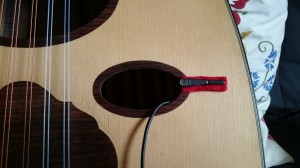 In order to combat this, I have occasionally stuffed a pillowcase into my Oud, and this prevents some distortion but takes away from the true sound of the Oud. This is one of the benefits of having an Oud with no rosettes, you can attach a mic inside your Oud. Fortunately, for feedback, this mic has the option that reduces the low frequency preventing feedback. This is especially useful for Oud players because the bowl of the Oud echos so much it is easy to create feedback. The mic is also equipped with phantom power. Phantom power boosts the signal making amplification easier.
In order to combat this, I have occasionally stuffed a pillowcase into my Oud, and this prevents some distortion but takes away from the true sound of the Oud. This is one of the benefits of having an Oud with no rosettes, you can attach a mic inside your Oud. Fortunately, for feedback, this mic has the option that reduces the low frequency preventing feedback. This is especially useful for Oud players because the bowl of the Oud echos so much it is easy to create feedback. The mic is also equipped with phantom power. Phantom power boosts the signal making amplification easier.
Amplifier
I think the amp I use is great. I use this amp for performing in large halls, or large houses. It’s a Fishman Loudbox Mini. I am really happy with it. It allows me to adjust the high middle and low frequencies, which is important in creating the particular sound you want. 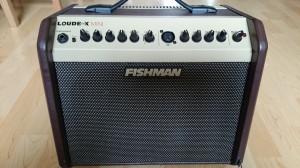
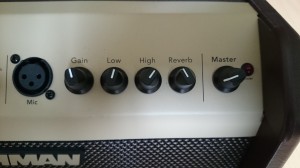
Frequencies: How to set equalization, High, Middle and Low
This is definitely a matter of taste and preference, but there are a few settings I like to use.
Bass
The Arabic Ouds are already bassy, so bass doesn’t need to be boosted too much. I would keep the bass level between half cut and not much beyond the middle. If you play Turkish Oud then you can increase the bass a bit, because Turkish Oud bowls are not as big as Arabic Oud bowls, creating less bass.
Middle
I like to have the middle frequencies enhanced when micing the Oud. This will add to the prominence of the Oud sound. But if you increase it too much you will distort the sound of your Oud. So you don’t want to go beyond the half way point on the plus side of the knob. For Turkish Ouds, the middle frequencies are already pronounced. So you don’t need to enhance the middle much.
High
Adjusting the high frequencies may be needed. I am guessing that in Persian ensembles the high frequencies of my Oud were taken down. When this happens the Oud can sound weak, and there will be no bite. An Oud should have some bite. If it doesn’t have enough bite it won’t be prominent and it won’t sound like a solo instrument. Turkish Ouds, on the other hand already have quite a bit of bite, so you probably don’t need to enhance the high. All of this depends on the quality of your microphone. If your microphone is good you probably won’t have to tweak or enhance anything, because it will be truer to the natural sound of the Oud.
Inexpensive Quality Microphone for Oud
One of the most common microphones out there for acoustic amplification is the Shure SM57. This is the most tried tested and true microphone out there for low cost. 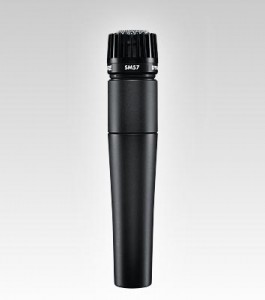 If you use this mic you definitely need a decent PA system with phantom power, or you can put the microphone through an active D/I box and that will help boost the signal. Instead of an active D/I box, you can get a plug it into your amp or PA system through a preamp. A preamp will also boost the signal giving you more sound to work with.
If you use this mic you definitely need a decent PA system with phantom power, or you can put the microphone through an active D/I box and that will help boost the signal. Instead of an active D/I box, you can get a plug it into your amp or PA system through a preamp. A preamp will also boost the signal giving you more sound to work with.
What Microphone To Avoid When Amplifying Your Oud
If you are using any type of condenser mic, make sure the mic has built in phantom power or the PA system/amp you’re using has phantom power, or else the mics will be pretty weak or will not work at all. Another common microphone is a contact mic. These are nice because they stick to your Oud. The best place to place these is on the surface close to the bridge. This mic picks up vibrations in the wood. They are okay, but if you are picky about sound quality, avoid these because the sound will be lacking. It is hard enough to get the right sound when you have the best equipment. But this is a decent budget option. 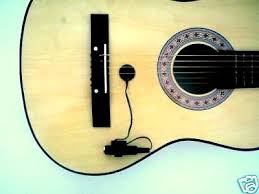
Cables
It is best to use cables that have the same input to output. For example, an xlr cable should go into an xlr input. A quarter inch cable should go into a quarter inch input. Some cables have a xlr on one side and quarter inch jack on the other side. This might change the integrity of the signal that is going into the Amplifier. So if your mic uses an xlr output then you should use a cable that is for xlr only. ![DSC_0012[1]](https://www.oudforguitarists.com/wp-content/uploads/2014/05/DSC_00121-300x168.jpg)
![DSC_0013[1]](https://www.oudforguitarists.com/wp-content/uploads/2014/05/DSC_00131-300x168.jpg)
![DSC_0014[1]](https://www.oudforguitarists.com/wp-content/uploads/2014/05/DSC_00141-300x168.jpg)
Where To Position Your Microphone
I think that the best position for any microphone is outside the Oud but mini condenser mics can often be placed inside the Oud. This often results in feedback if you are to close to the speakers or amplifier. For external mics like the Shure mics I recommend. This is where you can place the mic.
Infront of sound holes
![DSC_0016[1]](https://www.oudforguitarists.com/wp-content/uploads/2014/05/DSC_00161-1024x576.jpg) More toward the neck for more expensive condenser microphones that pick up a broader range of sound.
More toward the neck for more expensive condenser microphones that pick up a broader range of sound. ![DSC_0015[1]](https://www.oudforguitarists.com/wp-content/uploads/2014/05/DSC_00151-1024x576.jpg) If you place it closer to the bridge you will pick up a lot of attack from your risha. Again, all of this depends on the type of microphone you use, what type of PA system or amplifier, and gain level settings. If the gain is set higher, then the mic can be further from the Oud, if the gain is lower then the mic needs to be closer. I like to put the microphone closer to the sound holes so that there is a little attack from the risha and the full sound of the Oud goes into the microphone.
If you place it closer to the bridge you will pick up a lot of attack from your risha. Again, all of this depends on the type of microphone you use, what type of PA system or amplifier, and gain level settings. If the gain is set higher, then the mic can be further from the Oud, if the gain is lower then the mic needs to be closer. I like to put the microphone closer to the sound holes so that there is a little attack from the risha and the full sound of the Oud goes into the microphone.

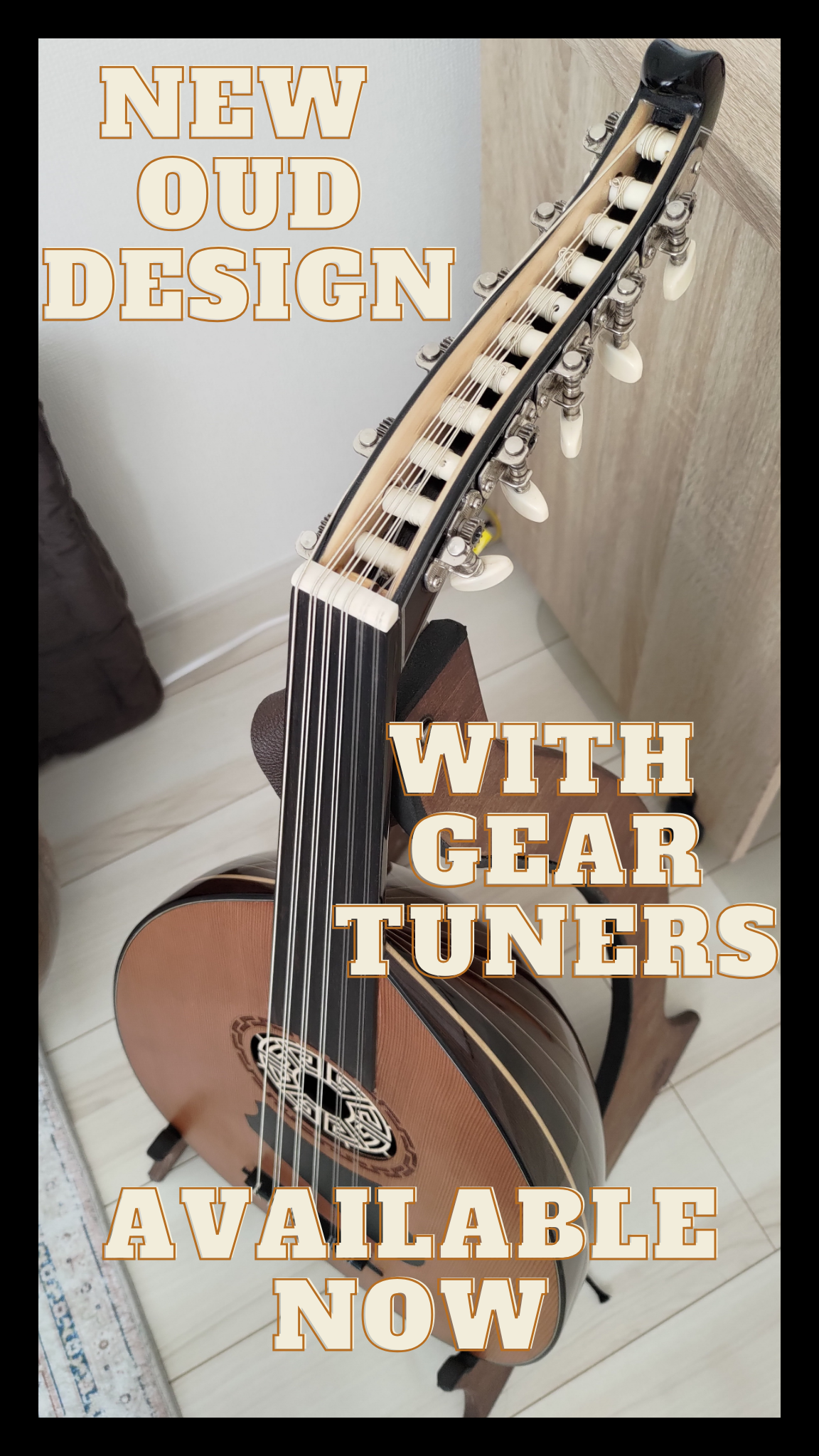
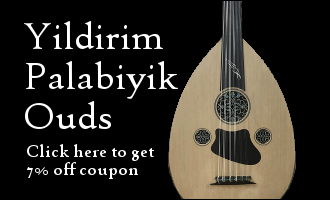
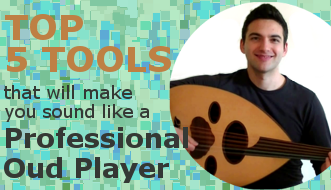


Hello and thank you very much for this interesting post. My father is an avid oud player and I would like to help him get your opinion on how he could amplify the sound of his oud, please 🙂
The clip would have been great, but the holes of his oud have something like a net in them, so he is reluctant about taking them out to install the clip on mic, the Shure SM57 is a great option though, and I will go for it.
Nonetheless given my very limited knowledge on the topic, I didn’t really understand what is the equipment I should by with the mic to make it good for the oud. We already have an amplifier at home (brother’s electric guitar), so can you tell me if a preamp with a mic is enough? and if yes could you please recommend any specific preamp?
Thank you very much
A preamp with a microphone should do the job. Maybe take it to a guitar shop and ask them for recommendations because they can show you exactly how to use the equipment too.
Hello Navid!
Do you have any suggestions for the use of pickups on the oud? I have a Fatih Ameen oud with K&K Twin Spot installed by the former owner. I also bought a Loudbox Mini which is a superb little amp, many positive comments in german shops made me buy it, and I’m not at all disappointed. The K&K Pickups don’t make much volume though, with gain and master on 12 o’clock I don’t even get feedback with the oud two meters from the amp. A preamp might be the cure, compact, maybe with a clip to have it nearby cause the pickups don’t have a volume control, maybe 20dB gain with no hiss. I’d be glad if you had some ideas.
Thanks a lot!
Hi Klaus,
With a contact style (piezzo style) pickup the only solution is a pre-amp. I personally prefer mini condenser microphones with phantom power, but these must usually be used with a clip on the edge of a soundhole. My Oud doesn’t have rosettes so I can use a clipped condenser mic.